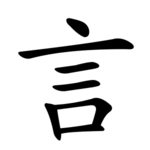| 言 | ||
|---|---|---|
| ||
| 言 (U+8A00) "speech" | ||
| Pronunciations | ||
| Pinyin: | yán | |
| Bopomofo: | ㄧㄢˊ | |
| Wade–Giles: | yen2 | |
| Cantonese Yale: | yìhn | |
| Jyutping: | jin4 | |
| Japanese Kana: | ゲン gen / ゴン gon (on'yomi) い-う i-u / こと koto (kun'yomi) | |
| Sino-Korean: | 언 eon | |
| Names | ||
| Chinese name(s): | (Left) 言字旁 yánzìpáng (Bottom) 言字底 yánzìdǐ | |
| Japanese name(s): | 言偏/ごんべん gonben | |
| Hangul: | 말씀 malsseum | |
| Stroke order animation | ||
 | ||
Radical 149 or radical speech (言部) meaning "speech" is one of the 20 Kangxi radicals (214 radicals in total) composed of 7 strokes.
In the Kangxi Dictionary, there are 861 characters (out of 49,030) to be found under this radical.
言 is also the 166th indexing component in the Table of Indexing Chinese Character Components predominantly adopted by Simplified Chinese dictionaries published in mainland China, with the simplified component form 讠 listed as its associated indexing component.
YouTube Encyclopedic
-
1/5Views:13 588589 1771 4273 75022 063
-
Watch: TODAY All Day - July 5
-
Wagle Ki Duniya - Ep 112 - Full Episode - 28th July, 2021
-
ART RITE Launch Event with Walter Robinson at JEFFREY DEITCH
-
#WashWeekPBS Extra: Supreme Court Confirmation Hearings & Mitch McConnell | Washington Week | PBS
-
Many False Traditions of Mecca! - Mecca - In Search of a Place - Episode 2
Transcription
Evolution
-
Oracle bone script character
-
Bronze script character
-
Large seal script character
-
Small seal script character
Derived characters
| Strokes | Characters (言 訁) | Characters (讠) |
|---|---|---|
| +0 | 言 訁Component | 讠SC Component (=訁) |
| +2 | 訂 訃 訄 訅 訆 (=叫 -> 口) 訇 計 | 计SC (=計) 订SC (=訂) 讣SC (=訃) 认SC (=認) 讥SC (=譏) |
| +3 | 訉 訊 訋 訌 訍 討 訏 訐 訑 訒 訓 訔 訕 訖 託 記 訙 訚SC (=誾) | 讦SC (=訐) 讧SC (=訌) 讨SC (=討) 让SC (=讓) 讪SC (=訕) 讫SC (=訖) 讬SC nonstandard (=託) 训SC (=訓) 议SC (=議) 讯SC (=訊) 记SC (=記) 讱SC (=訒) |
| +4 | 訛 訜 訝 訞 訟 訠 (=矧 -> 矢) 訡 (=吟 -> 口) 訢 訣 訤 訥 訦 訧 訨 訩 訪 訫 訬 設 訮 訯 訰 許 訲 訳JP (=譯) | 讲SC (=講) 讳SC (=諱) 讴SC (=謳) 讵SC (=詎) 讶SC (=訝) 讷SC (=訥) 许SC (=許) 讹SC (=訛) 论SC (=論) 讻SC (=訩) 讼SC (=訟) 讽SC (=諷) 设SC (=設) 访SC (=訪) 诀SC (=訣) |
| +5 | 訴 訵 訶 訷 訸 訹 診 註 証JP (=證) 訽 訾 訿 詀 詁 詂 詃 詄 詅 詆 詇 詈 詉 詊 詋 (=咒 -> 口) 詌 詍 詎 詏 詐 詑 詒 詓 詔 評 詖 詗 詘 詙 詚 詛 詜 詝 詞 詟SC (=讋) 詠 | 证SC (=證) 诂SC (=詁) 诃SC (=訶) 评SC (=評) 诅SC (=詛) 识SC (=識) 诇SC (=詗) 诈SC (=詐) 诉SC (=訴) 诊SC (=診) 诋SC (=詆) 诌SC (=謅) 词SC (=詞) 诎SC (=詘) 诏SC (=詔) 诐SC (=詖) 译SC (=譯) 诒SC (=詒) |
| +6 | 詡 詢 詣 詤 詥 試 詧 (=察 -> 宀) 詨 詩 詪 詫 詬 詭 詮 詯 詰 話 該 詳 詴 詵 詶 (=酬 -> 酉 / 籌 -> 竹) 詷 詸 (=謎) 詹 詺 詻 詼 詽 (=訮) 詾 (=訩) 詿 誀 誁 誂 誃 誄 誅 誆 誇 誈 誉SC/JP (=譽) 誊SC (=謄) 誠 | 诓SC (=誆) 诔SC (=誄) 试SC (=試) 诖SC (=詿) 诗SC (=詩) 诘SC (=詰) 诙SC (=詼) 诚SC (=誠) 诛SC (=誅) 诜SC (=詵) 话SC (=話) 诞SC (=誕) 诟SC (=詬) 诠SC (=詮) 诡SC (=詭) 询SC (=詢) 诣SC (=詣) 诤SC (=諍) 该SC (=該) 详SC (=詳) 诧SC (=詫) 诨SC (=諢) 诩SC (=詡) |
| +7 | 誋 誌 認 誎 誏 誐 誑 誒 誓 誔 誕 誖 (=悖 -> 心) 誗 誘 誙 誚 誛 誜 誝 語 誟 誡 誢 誣 誤 誥 誦 誧 誨 誩 說 誫 説JP/HK (=說) 読JP (=讀) 誮 | 诪SC (=譸) 诫SC (=誡) 诬SC (=誣) 语SC (=語) 诮SC (=誚) 误SC (=誤) 诰SC (=誥) 诱SC (=誘) 诲SC (=誨) 诳SC (=誑) 说SC (=說) 诵SC (=誦) 诶SC (=誒) |
| +8 | 誯 誰 誱 課 誳 誴 誵 誶 誷 誸 誹 誺 誻 誼 誽 誾 調 諀 諁 (=啜 -> 口) 諂 諃 諄 諅 諆 談 諈 諉 諊 請 諌 諍 諎 諏 諐 (=愆 -> 心) 諑 諒 諓 諔 諕 論 諗 諘 諙 諚 諩 | 请SC (=請) 诸SC (=諸) 诹SC (=諏) 诺SC (=諾) 读SC (=讀) 诼SC (=諑) 诽SC (=誹) 课SC (=課) 诿SC (=諉) 谀SC (=諛) 谁SC (=誰) 谂SC (=諗) 调SC (=調) 谄SC (=諂) 谅SC (=諒) 谆SC (=諄) 谇SC (=誶) 谈SC (=談) 谉SC (=讅) 谊SC (=誼) |
| +9 | 諛 諜 諝 諞 諟 諠 諡 (=謚) 諢 諣 諤 諥 諦 諧 諨 諪 諫 諬 (=啟 -> 攴) 諭 諮 諯 諰 諱 諲 諳 諴 諵 諶 諷 諸 諹 諺 諻 諼 諽 諾 諿 謀 謁 謂 謃 謡JP (=謠) | 谋SC (=謀) 谌SC (=諶) 谍SC (=諜) 谎SC (=謊) 谏SC (=諫) 谐SC (=諧) 谑SC (=謔) 谒SC (=謁) 谓SC (=謂) 谔SC (=諤) 谕SC (=諭) 谖SC (=諼) 谗SC (=讒) 谘SC (=諮) 谙SC (=諳) 谚SC (=諺) 谛SC (=諦) 谜SC (=謎) 谝SC (=諞) 谞SC (=諝) |
| +10 | 謄 謅 謆 謇 謈 謉 謊 謋 謌 (=歌 -> 欠) 謍 謎 謏 謐 謑 謒 謓 謔 謕 謖 謗 謘 謙 謚 講 謜 謝 謞 謟 謠 謡 (=謠) 謢 (=護) | 谟SC (=謨) 谠SC (=讜) 谡SC (=謖) 谢SC (=謝) 谣SC (=謠) 谤SC (=謗) 谥SC (=謚) 谦SC (=謙) 谧SC (=謐) |
| +11 | 謣 謤 謥 謦 謧 謨 謩 (=謨) 謪 謫 謬 謭 (=譾) 謮 謯 謰 謱 謲 謳 謴 謵 謶 謷 謸 謹 謺 謻 謼 謽 謾 | 谨SC (=謹) 谩SC (=謾) 谪SC (=謫) 谫SC (=譾) 谬SC (=謬) |
| +12 | 謿 (=嘲 -> 口) 譀 譁 (=嘩 -> 口) 譂 譃 譄 譅 譆 譇 譈 證 譊 譋 (=讕) 譌 (=訛/詭) 譎 譏 譐 譑 譒 譓 譔 譕 譖 譗 識 譙 譚 譛 (=譖) 譜 | 谭SC (=譚) 谮SC (=譖) 谯SC (=譙) 谰SC (=讕) 谱SC (=譜) 谲SC (=譎) |
| +13 | 譍 (=應 -> 心) 譝 譞 譟 (=噪 -> 口) 譠 譡 (=讜) 譢 譣 譤 譥 警 譧 譨 譩 譪 (=藹 -> 艸) 譫 譬 譭 譮 譯 議 譱 (=善 -> 口) 譲JP (=讓) | 谳SC (=讞) 谴SC (=譴) 谵SC (=譫) |
| +14 | 譳 譴 譵 (=懟 -> 心) 譶 護 譸 譹 譺 譻 (=嚶 -> 口) 譼 譽 | |
| +15 | 譾 譿 讀 讁 (=謫) 讂 讃JP (=讚) 讄 讅 | |
| +16 | 讆 讇 (=諂) 讈 讉 變 讋 讌 讍 讎 讏 (=讆) 讐JP (=讎) | |
| +17 | 讑 讒 讓 讔 讕 讖 | 谶SC (=讖) |
| +18 | 讗 讘 讙 | |
| +19 | 讚 讛 | |
| +20 | 讜 讝 讞 | |
| +22 | 讟 |
Variant forms
The first stroke of this radical character is printed differently in different languages, while in writing, the slant dot form is overwhelmingly preferred.
| Kangxi Dict. Japanese Korean |
Trad. Chinese Simp. Chinese |
|---|---|
| 言 | 言 |
In addition, when used as a left component, this character is simplified as 讠 in Simplified Chinese.
Sinogram
The radical is also used as an independent Chinese character. It is one of the Kyōiku kanji or Kanji taught in elementary school in Japan.[1] It is a second grade kanji[1]
References
- ^ a b "The Kyoiku Kanji (教育漢字) - Kanshudo". www.kanshudo.com. Archived from the original on March 24, 2022. Retrieved 2023-05-06.
Literature
- Fazzioli, Edoardo (1987). Chinese calligraphy : from pictograph to ideogram : the history of 214 essential Chinese/Japanese characters. calligraphy by Rebecca Hon Ko. New York: Abbeville Press. ISBN 0-89659-774-1.
- Lunde, Ken (Jan 5, 2009). "Appendix J: Japanese Character Sets" (PDF). CJKV Information Processing: Chinese, Japanese, Korean & Vietnamese Computing (Second ed.). Sebastopol, Calif.: O'Reilly Media. ISBN 978-0-596-51447-1.




